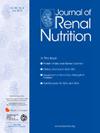Short Report: Influence of Dark Chocolate Intake on Magnesium Status in Hemodialysis Patients
IF 3.2
3区 医学
Q2 NUTRITION & DIETETICS
引用次数: 0
Abstract
Objective
Magnesium (Mg2+) deficiency can be observed in patients with chronic kidney disease (CKD) and is associated with increased inflammation, disease progression, and mortality. Dark chocolate is an excellent source of Mg2+. This study aimed to evaluate the effect of 70% cocoa chocolate intake on Mg2+ serum levels in patients with CKD on hemodialysis (HD).
Methods
These are secondary analyses from a previous controlled pilot study. The study included 59 patients undergoing HD. Patients were allocated into 2 groups: dark chocolate and the control group. The dark chocolate group received 40 g of 70% cocoa chocolate for 2 months during HD sessions (3 times a week). The control group did not receive any intervention. Mg2+ was evaluated by a colorimetric test using a commercial kit (Bioclin®). NCT04600258 on March 1, 2020, retrospectively registered.
Results
Thirty-five patients in the dark chocolate group (17 women, 53.4 ± 12.9 years) and 11 in the control group (4 women, 46.7 ± 10.9 years) completed the study. The median (interquartile range) overall Mg2+ serum levels were 2.4 (0.4) mg/dL, with no significant differences between the groups. After 2 months of supplementation, serum levels of Mg2+ increased significantly in the dark chocolate group from 2.5 (2.4˗2.6) to 2.7 (2.6˗2.8) mg/dL (P < .01). No change was observed in potassium and phosphorus plasma levels.
Conclusions
Dark chocolate might be a promising nutritional strategy to improve Mg2+ levels in patients with CKD on HD. The offered dose was safe, not altering plasma phosphorus and potassium levels.

短报告:黑巧克力摄入对血液透析患者镁状态的影响。
目的:慢性肾脏病(CKD)患者会出现镁(Mg2+)缺乏症,并与炎症、疾病进展和死亡率增加有关。黑巧克力是镁的最佳来源。本研究旨在评估摄入 70% 可可巧克力对接受血液透析(HD)的慢性肾脏病患者血清镁水平的影响。研究包括 59 名接受血液透析的患者。患者被分为两组:巧克力组和对照组。巧克力组在两个月的时间里,在血液透析过程中服用 40 克 70% 可可巧克力(每周 3 次)。对照组不接受任何干预。通过使用商业试剂盒(Bioclin®)进行比色测试来评估 Mg2+。[结果:巧克力组 35 名患者(17 名女性,53.4 ± 12.9 岁)和对照组 11 名患者(4 名女性,46.7 ± 10.9 岁)完成了研究。总体 Mg2+ 血清水平的中位数(四分位数间距)为 2.4 (0.4) mg/dL,组间无显著差异。补充两个月后,巧克力组的血清 Mg2+ 水平从 2.5(2.4-2.6)毫克/分升显著升高至 2.7(2.6-2.8)毫克/分升(p结论:黑巧克力可能是改善接受血液透析治疗的慢性肾脏病患者体内 Mg2+ 水平的一种有前途的营养策略。提供的剂量是安全的,不会改变血浆磷和钾的水平。
本文章由计算机程序翻译,如有差异,请以英文原文为准。
求助全文
约1分钟内获得全文
求助全文
来源期刊

Journal of Renal Nutrition
医学-泌尿学与肾脏学
CiteScore
5.70
自引率
12.50%
发文量
146
审稿时长
6.7 weeks
期刊介绍:
The Journal of Renal Nutrition is devoted exclusively to renal nutrition science and renal dietetics. Its content is appropriate for nutritionists, physicians and researchers working in nephrology. Each issue contains a state-of-the-art review, original research, articles on the clinical management and education of patients, a current literature review, and nutritional analysis of food products that have clinical relevance.
 求助内容:
求助内容: 应助结果提醒方式:
应助结果提醒方式:


